Massachusetts is home to many varieties of mushrooms, including multiple wild edible mushrooms. Foraging mushrooms in Massachusetts can be fulfilling when you know what to look for. The following list is a short list of common edible mushrooms found throughout the state!
Disclaimer
This article does not describe the details needed to thoroughly identify these mushrooms. Deadly and otherwise toxic look-a-likes do exist and may even be common in your area. Before foraging for any mushroom please spend the time to thoroughly Identify the mushroom using multiple sources.
Winecap (Stropharia rugoso-annulata)
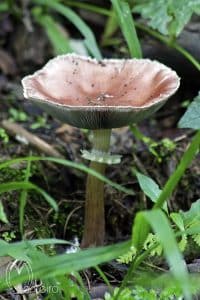
This luxuriously-named mushroom is named for its rich, burgundy color. Winecap is also known as Garden Giant mushroom. It is native to Europe and North America and has a burgundy top with grey gills and white flesh. The Winecap mushroom reaches an average height of eight inches and 12 inches in width. It grows most often from spring to autumn, particularly along streambeds. It’s important to remember that the mushroom cap flattens with age.
Chicken of the Woods (Laetiporus sulphureus)
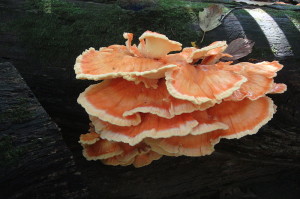
Chicken of the Woods is a particularly easy-to-spot mushroom in the wild, as this mushroom has a vibrant orange color. Chicken of the Woods is also known as Sulphur Shelf, as it resembles a shelf-like structure. However, Chicken of the Woods was named based on its texture and flavor, which has been described to resemble chicken meat. This mushroom often reaches two to 10 inches in width and can weigh over 100 pounds. It is most commonly found on decaying or dead oak trees and is best harvested from spring to autumn.
Golden Chanterelle (Cantherallus cibarius)
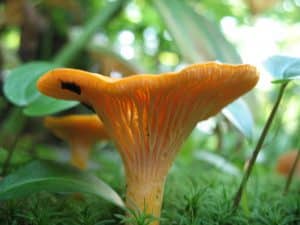
Another bold yellow-orange mushroom is the Golden Chanterelle. This funnel-shaped mushroom grows underneath live oak trees, sprouting from the soil alongside the trunk, from late June to early August. Golden Chanterelle mushrooms have a curved stalk and a smooth texture. The cap reaches between a half-inch and six inches, with the stalk averaging one to three inches tall. When searching for this mushroom, be aware of its poisonous lookalike, the Jack O Lantern mushroom, or the Omphalotus illudens.
Black Trumpet (Craterellus cornucopioides)
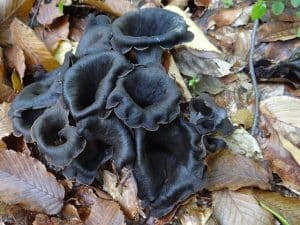
Black trumpet mushrooms are a common black fungus that grows in forests, sprouting from the soil. You will most commonly find the Black Trumpet mushroom alongside the trunk of an oak or beech tree. This mushroom grows in patches, so where you find a few mushrooms, there are sure to be more in the nearby area, forming in clusters that spread between three and 13 feet. Common places to find these patches include logging roadsides, moss patches, and steep banks between the months of June to September. There are no known similar lookalikes to this mushroom.
Hen of the Woods (Grifola Frondosa)
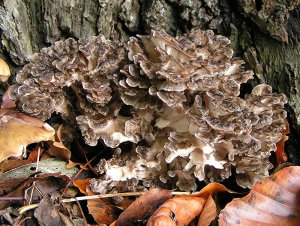
Hen of the Woods is also known as Sheep’s Head mushroom or Ram’s Head mushroom. Hen of the Woods predominantly grows in older forests, at the base of oak trees mostly, and in northern climates near bodies of water. This mushroom is brown or grey with white edges, with flat or ruffled caps, reaching between four and 36 inches wide and two or three feet tall. They can even weigh up to 30 pounds! Autumn is the best time to forage Hen of the Woods.
Lobster mushroom (Hypomyces Lactifluorum)

The Lobster mushroom is an interesting specimen as it doesn’t grow on decaying trees or along forest floors, but rather on other species of mushrooms. This turns the outer shells of mushrooms into a bold red-orange color, similar to the shell of a lobster. Lobster mushroom often grows on members of milk cap and brittlegill mushrooms. The surface of the mushroom is hard and develops hard pimple-like bumps. This hard surface prevents the host mushroom from producing spores. The size of a Lobster mushroom depends on the host mushroom, but it often grows between six to eight inches tall.
Velvet Foot (Flammulina Velutipes)

Velvet foot mushroom is also known as the Winter mushroom, wild enoki, and velvet stem mushroom. Velvet foot is either a reddish-brown or yellowish-brown color. The gills underneath the cap are more white in color. The stem is thick and often yellow with a brown or black velvet texture. The mushroom has a mild flavor but is bolder than the cultivated variety. You can find Velvet Foot growing on hardwood stumps or logs in a clump formation, but sometimes in single mushrooms, during fall and summer. To avoid the poisonous lookalike, Galerina autumnalis, make sure that the spores are white.
Bear’s Head-Tooth (Hericium americanum)

The Bear’s Head-Tooth mushroom is also known as the Western Coral Hedgehog mushroom. You may also see this fungus referred to as Monkey’s Head, Lion’s Mane, and a few other names. However, Bear’s Head-Tooth mushroom is actually a relative to the real Lion’s Mane mushroom! Bear’s Head Tooth is composed of a mass of long spines that hang down and are off-white or pale yellow. The fruit bodies often range between four and 30 inches tall and wide, often growing on conifer stumps. While this mushroom is edible, it should be cooked prior to consumption.
Reishi (Ganoderma Lucidum and others)
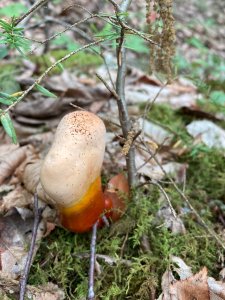
The Reishi mushroom is a marvel of a mushroom that is easy to identify by its deep mahogany color and shiny, shellacked cap. There are 16 varieties of reishi mushrooms, two of which grow in Massachusetts, including Hemlock reishi. All reishi mushrooms feed on dead matter, so you’ll find them on dying or dead trees, stumps, or logs. Some varieties are found on hardwood trees, but hemlock reishi mushrooms often grow on conifers. Reishi mushrooms grow from spring to fall.
With this list, you can easily begin your mushroom foraging journey and start familiarizing yourself with the local fungi throughout Massachusetts.

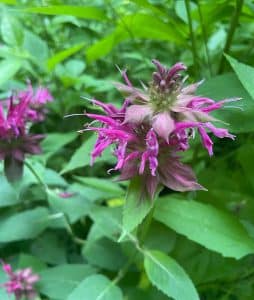
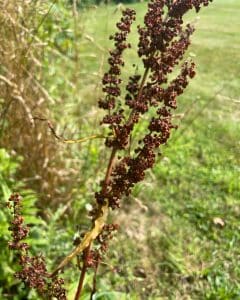



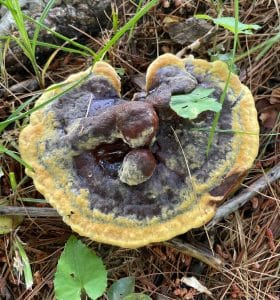
One Response
I’m quite interested finding a foraging tour for the spring. I am in Queens,NY and am looking for a forager/cultivator to purchase some chicken of the woods etc. from NY, Mass, CT, NJ area. Perhaps a green market?